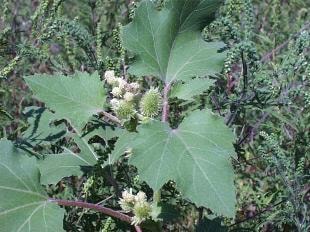Auricularia aurantium, a medicine for treating nasal diseases
Xanthium strumarium is the seed of the Xanthium strumarium fruit, with the medicinal name Fructus Xanthii, scientific name Xanthium strumarium L, belonging to the Asteraceae family.
This is a wild plant that grows everywhere in our country, along roadsides, vacant lots or abandoned fields; it has many other names such as Ke dau ngua, Thuong nhi, Phat ma, Mac nang (Tay)... It is an annual herb, 40 - 70 cm high, green stem, grooved, sometimes with purple-brown spots. Leaves grow alternately, divided into irregular lobes, serrated edges, with short and hard hairs. The flower pulp is shaped like a head and grows in the leaf axils. The fruit is egg-shaped with hooks.
Oriental medicine believes that the fruit of the Chinese clematis plant has a sweet taste, warm properties, and enters the Lung meridian. Some documents say that it has a spicy and bitter taste, warm properties, and is slightly toxic, with the function of clearing the nose, eliminating rheumatism, and relieving pain. That is, it has the effect of dispersing, eliminating wind, and transforming heat. It is used to treat symptoms such as headaches caused by wind-cold, night blindness, runny nose, and sores.

Many other documents also say it is used as an anti-allergy, anti-inflammatory medicine to treat boils, ulcers, hives, scrofula, goiter, joint pain, runny nose, sore throat, dysentery, the fruit decoction can be used to treat toothache, applied to treat hair fungus, ringworm..., such as runny nose with symptoms of headache, stuffy nose, runny nose, loss of smell (sinusitis), rheumatism with symptoms of joint pain and cramps in the limbs... The average dose for each dose of medicine is from 6 - 12g, sometimes up to 40g per day.
The part used as medicine is the fruit, harvested in autumn, when the fruit has not yet turned yellow, dried in the sun or dried, then burned to remove the thorns, then using gloves to separate the seeds, remove all impurities from the shell, take the seeds and store them for later use.
However, Shang Er Zi cannot be used widely for all subjects, for example, people with headaches due to blood deficiency or numbness should not use it. Especially note that overdose should not be used because it will cause poisoning, vomiting, stomachache and diarrhea.
Treatment of allergic rhinitis:Use the "Thuong Nhi San" recipe of the famous physician Nghiem Dung Hoa of the Song Dynasty, including 8g of Thuong Nhi Tu, 15g of Tan Di Hoa, 30g of Bach Chi, and 3g of Bac Ha. Dry the ingredients and grind them into a fine powder. Take 6g twice a day, with the decoction of green onions or fresh tea leaves for better results.
This remedy will help clear the nose and relieve headaches. It is often used to treat allergic rhinitis, acute rhinitis, acute or chronic sinusitis.
Treatment of rhinitis and sinusitis caused by wind heat:Ephedra 12g, Magnolia flower 8g, Asarum 12g, Euryale aurantium 12g, Perilla fruticosa 6g, Saposhnikovia divaricata 12g, Licorice 4g, decoct and drink 1 dose per day, divided into 2 times, should drink for 3-5 consecutive days.
Treatment of atrophic rhinitis (called Ti ca in Oriental medicine):Symptoms of dry rhinitis, is a chronic rhinitis, has a characteristic of slow progression, the disease often occurs more in women, symptoms worsen during pregnancy or menstruation. We see the nasal mucosa shrink, causing dryness in the vomer bone, causing the vomer bone to narrow, the nasal cavity to widen, forming many green scales, causing nasal congestion. The following methods can be used:
- Decoction: 15g of Chinese clematis root, 15g of Chinese clematis root, 15g of Ophiopogon japonicus, 15g of mulberry leaves, 15g of Scutellaria baicalensis, 15g of honeysuckle, 10g of Chinese angelica root, 10g of Ligusticum wallichii, 10g of peppermint, 10g of Saposhnikovia divaricata, 20g of gypsum, 20g of forsythia root, 12g of alum, 10g of Pogostemon caeruleum, 10g of almonds, 20g of fish mint. Decoction: 1 dose per day, divided into 2-3 times, need to drink 5-7 doses.
- Drop Shang Er Zi oil: Drop 3 times a day to treat dry atrophic rhinitis.
Or 160g of Chinese clematis seeds, 160g of Magnolia flowers, 1,000ml of sesame oil. Heat the oil, add crushed Chinese clematis seeds and Chinese clematis flowers and soak for 24 hours. After boiling, leave 800ml to cool, filter the residue, and store in a sealed container. Drop into the nose 3 times a day for 30 consecutive days to effectively treat atrophic and dry rhinitis.
According to Vietnam Agriculture - NT
